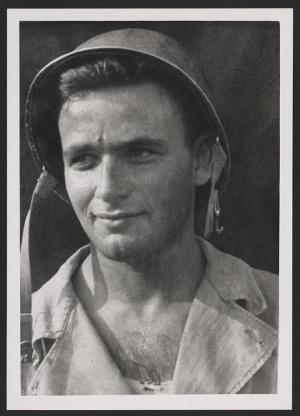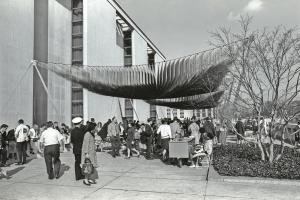
Happy 90th birthday to the wonderful Victor Lundy! Lundy's architecture defines a kind of organic mid-century modernism, and he is admired as much for his sculptural sense of form as for his innovative use of engineering technology. Both of these qualities are on view in the work that he created for the Smithsonian in the mid-1960s – a series of "shade structures" for the terrace of the new Museum of History and Technology (as the National Museum of American History was then known). The creation of a terrace café to enliven the Mall formed part of the Smithsonian's contributions to Lady Bird Johnson's campaign to beautify Washington.
Lundy's work is rooted in his superb draftsmanship, and he still paints and draws today from his home and studio in Texas. After serving in the U.S. Army during World War II, he studied under Walter Gropius at Harvard, where among his classmates were I. M. Pei, Edward Larrabee Barnes, and Paul Rudolph. He then moved to Sarasota, Florida, in the 1950s, where he started his first office – rising to prominence in the heady environment of Sarasota's modernist movement. While he is perhaps best known for his churches, with their inventive and inspired rooflines (see for example his First Unitarian Church in Westport, Connecticut), my personal favorite are the "Space Flowers" he designed for the New York World's Fair of 1964-1965.

In 1965, when Lundy started working with the Smithsonian, he was one of several featured in a landmark exhibition about contemporary American architecture held in the Soviet Union (the other architects were Louis Kahn, Robert Venturi, Paul Rudolph, and Charles Eames). The Smithsonian that year was celebrating the Bicentennial of James Smithson's birth with a three-day celebration and an academic procession full of pomp and circumstance along the Mall.

The six shade structures, which Lundy likened to "abstract trees," were unveiled on September 1, 1965. The slatted canopies – three on either side of the Mall entrance to the museum – intercepted the sun, while still allowing light and breezes to filter through. The museum's chief of exhibits at the time, Benjamin Lawless, said, "It creates a graceful pattern of swooping cables and lines and will soften the contour of the building and put some life in the area . . ." The shade structures lasted until the late 1970s, when they were removed on account of deterioration. Lundy had intended for them to be taken down each fall and stored over the winter, to extend their life span, but this had not happened. Briefly in 1978 there was a flurry of correspondence regarding the feasibility of remaking them in more permanent materials, such as aluminum and stainless steel, but the project was ultimately not pursued. The Archives has some images of the shade structures, but do you have memories or pictures of them to share?
2013 is shaping up to be a banner year for Lundy. The Library of Congress is in the process of acquiring Lundy's papers (it has already accessioned his World War II notebooks, which they have beautifully digitized). And the General Services Administration, which manages the U.S. Tax Court, one of Lundy's most significant projects, recently succeeded in having that building landmarked; they are also completing a film on the life and work of the architect.
Related Resources
- The Art and Architecture of Anstis and Victor Lundy, exhibition (Image number three includes a Lundy sketch of one of the Smithsonian shade structures as viewed from underneath), Ballroom Marfa, 2006
Related Collections
Produced by the Smithsonian Institution Archives. For copyright questions, please see the Terms of Use.

Leave a Comment